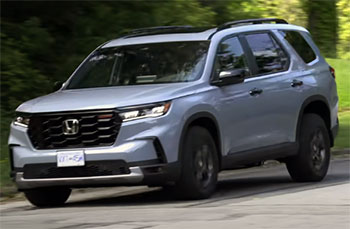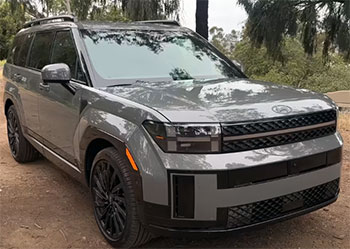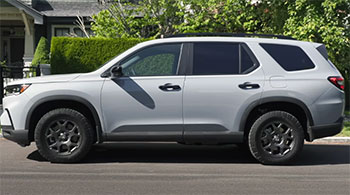As a parent juggling soccer practices, grocery runs, and the occasional road trip, I’ve been on the hunt for the perfect family SUV. The 2025 Honda Pilot and the 2024 Hyundai Santa Fe caught my eye, both promising space, tech, and reliability.
My goal here is to compare these two midsize, three-row SUVs from a real-world perspective, weighing their strengths and weaknesses to help you decide which fits your family’s needs. Below, I’ve laid out a comparison table to kick things off, followed by my hands-on experience, pros, cons, and answers to common questions.
Comparison Table: Honda Pilot Vs. Hyundai Santa Fe
| Feature | 2025 Honda Pilot | 2024 Hyundai Santa Fe |
|---|---|---|
| Starting MSRP | $41,650 | $34,200 |
| Engine Options | 3.5L V6 (285 hp, 262 lb-ft) | 1.6L Turbo Hybrid (231 hp, 271 lb-ft) or 2.5L Turbo (277 hp, 311 lb-ft) |
| Fuel Economy (MPG) | 19 city/27 hwy/22 combined (AWD) | 20 city/29 hwy/24 combined (FWD Hybrid) |
| Seating Capacity | Up to 8 | Up to 7 |
| Cargo Space (cu. ft.) | 18.6 behind 3rd row, 87.0 max | 14.6 behind 3rd row, 80.0 max |
| Towing Capacity | 5,000 lbs (AWD) | 5,000 lbs (Turbo) |
| Infotainment | 9-inch touchscreen, Apple CarPlay | 12.3-inch touchscreen, Apple CarPlay |
| Safety Rating | 5-star NHTSA, IIHS Top Safety Pick+ | 5-star NHTSA, IIHS Top Safety Pick+ |
| Warranty | 3-yr/36,000-mile basic, 5-yr/60,000-mile powertrain | 5-yr/60,000-mile basic, 10-yr/100,000-mile powertrain |
| Maintenance | 2-yr/24,000-mile complimentary | 3-yr/36,000-mile complimentary |
My Experience With the Honda Pilot
Driving the 2025 Honda Pilot felt like slipping into a familiar pair of shoes—comfortable, reliable, but not flashy. I took it for a spin over a weekend, hauling my kids, their sports gear, and a cooler for a picnic. The Pilot’s 3.5-liter V6 engine, pumping out 285 horsepower, handled highway merging with ease, though it didn’t exactly thrill me with its acceleration.
The 10-speed automatic transmission shifted smoothly, but I noticed a slight grumble from the engine under heavy loads, like climbing a steep hill with a full car.

The interior screamed practicality. With seating for eight, I could fit my kids, their friends, and even my in-laws without anyone complaining about being cramped.
The second-row bench was a lifesaver for carpool days, though I envied the captain’s chairs in higher trims for easier third-row access.
Speaking of the third row, it’s roomy enough for adults on short trips, but my teenagers grumbled about legroom on longer drives.
Cargo space was a highlight—18.6 cubic feet behind the third row meant I could toss in groceries without folding seats.
Tech-wise, the 9-inch touchscreen was intuitive, syncing effortlessly with my phone via Apple CarPlay.
The Honda Sensing suite, with adaptive cruise control and lane-keeping assist, made highway driving less stressful, especially in traffic.
However, the Pilot’s infotainment felt a bit dated compared to newer systems, and the lack of standard satellite radio on base trims was a letdown.
Off-road, I tested the Pilot TrailSport trim on a gravel trail. It handled light dirt paths fine, but don’t expect it to conquer rugged terrain. The all-wheel-drive system gave me confidence on slippery roads, though. Overall, the Pilot felt like a dependable workhorse—great for families who value space and reliability over excitement.
Pros Of the Honda Pilot
- Spacious interior: The Pilot’s cabin is a game-changer for large families, offering seating for up to eight. The second row is wide enough to prevent sibling squabbles, and the 18.6 cubic feet of cargo space behind the third row easily swallowed my family’s gear for a weekend trip. Folding the second and third rows opens up a massive 87 cubic feet, perfect for hauling furniture or camping equipment.
- Strong safety ratings: With a five-star NHTSA rating and an IIHS Top Safety Pick+ award, the Pilot gave me peace of mind. The Honda Sensing suite, standard across trims, includes collision mitigation braking, road departure mitigation, and adaptive cruise control, which kept me relaxed during rush-hour drives.
- Reliable V6 engine: The 3.5-liter V6 delivers 285 horsepower and 262 lb-ft of torque, making it a solid performer for highway cruising or towing up to 5,000 pounds. It’s not the fastest, but it gets the job done without fuss, and the 10-speed automatic ensures smooth shifts.
- Versatile seating options: The option for second-row captain’s chairs in higher trims makes third-row access a breeze, though the standard bench seat is great for bigger groups. I appreciated the flexibility for different family needs.
- Resale value: The Pilot holds its value well, losing about 43.6% over five years, slightly better than competitors. This made me feel confident about its long-term investment potential.
- Comfortable ride: The suspension soaked up bumps on pothole-ridden roads, making long drives comfortable. My kids even napped in the back, which is a rare win.
Read More: My Thoughts On Acura MDX Vs. Volvo XC90
Cons Of the Honda Pilot
- Higher starting price: At $41,650, the Pilot’s base MSRP is significantly pricier than the Santa Fe’s $34,200. For budget-conscious families like mine, that’s a big gap, especially when base trims lack some premium features like heated seats or satellite radio.
- Mediocre fuel economy: The Pilot’s 19 city/27 highway MPG (AWD) isn’t terrible, but it lags behind hybrid competitors. I found myself stopping for gas more often than I’d like on long trips, with a combined 22 MPG.
- Dated infotainment: The 9-inch touchscreen works fine, but it feels a generation behind in design and responsiveness. Competitors offer larger, sharper displays, and I missed having standard satellite radio or more intuitive menus.
- Noisy engine under load: The V6 gets loud when pushed, like during hill climbs or heavy acceleration. It’s not a dealbreaker, but it disrupted the otherwise quiet cabin, which annoyed my wife on our test drive.
- Limited third-row comfort: While the third row fits adults, it’s tight for long trips. My teenagers complained about legroom after an hour, and accessing it without captain’s chairs was a hassle.
- Less advanced tech features: The Pilot’s tech suite is solid but lacks cutting-edge options like remote parking assist or a driver attention camera, which some rivals offer. I felt like I was missing out on the latest innovations.
My Experience With the Hyundai Santa Fe

The 2024 Hyundai Santa Fe was a breath of fresh air.
Its bold, boxy redesign turned heads when I pulled into the school parking lot, and I couldn’t help but grin at its rugged vibe.
I tested the hybrid model, with a 1.6-liter turbo engine and electric motor delivering 231 horsepower and 271 lb-ft of torque.
It felt peppier than expected, especially in city traffic, and the six-speed automatic was buttery smooth.
The top-tier Calligraphy trim’s 2.5-liter turbo engine (277 horsepower) was even punchier, though I stuck with the hybrid for its fuel savings.
Inside, the Santa Fe’s cabin felt modern and upscale. The 12.3-inch touchscreen was a standout, with crisp graphics and seamless Apple CarPlay integration.
The digital gauge cluster added a futuristic touch, and I loved the UV-C sanitizing tray in the top trim—perfect for cleaning my kids’ sticky phones. Seating up to seven, the Santa Fe was cozy but spacious, with 44.4 inches of front legroom and 42.3 inches in the second row.
The third row, however, was best for kids, and the 14.6 cubic feet of cargo space behind it felt cramped compared to the Pilot.
Safety features were a highlight. The Santa Fe’s IIHS Top Safety Pick+ and five-star NHTSA rating matched the Pilot, but extras like Forward Attention Warning and Remote Smart Parking Assist (on higher trims) felt next-level. I tested the parking assist in a tight lot, and it was like magic—though I’d rarely use it.
The hybrid’s 20 city/29 highway MPG was a win, letting me skip gas stations on busy weeks. Off-road, the XRT trim tackled light trails well, though, like the Pilot, it’s no hardcore adventurer. The Santa Fe felt like a tech-savvy, budget-friendly choice with a lot of personality.
Pros Of the Hyundai Santa Fe
- Affordable price point: Starting at $34,200, the Santa Fe undercuts the Pilot by over $7,000. Even loaded trims like the Calligraphy stay competitive, making it a great value for families on a budget like mine.
- Impressive fuel economy: The hybrid’s 20 city/29 highway MPG (FWD) saved me money at the pump. Even the non-hybrid turbo gets 22 city/28 highway, outpacing the Pilot’s thirstier V6.
- Modern tech features: The 12.3-inch touchscreen and digital gauge cluster are sleek and user-friendly. Features like the UV-C sanitizing tray and Remote Smart Parking Assist (on higher trims) made me feel like I was driving the future.
- Strong warranty: Hyundai’s 5-year/60,000-mile basic and 10-year/100,000-mile powertrain warranties are unmatched. The 3-year/36,000-mile complimentary maintenance was a nice bonus, easing my mind about long-term costs.
- Bold design: The Santa Fe’s boxy, rugged look stands out in a sea of bland SUVs. It felt fresh and confident, earning compliments from neighbors during my test drive.
- Advanced safety suite: Beyond standard features like blind-spot monitoring and rear cross-traffic alerts, the Santa Fe offers unique options like Forward Attention Warning, which uses a camera to monitor driver focus, keeping me alert on long drives.
Cons Of the Hyundai Santa Fe
- Limited cargo space: With just 14.6 cubic feet behind the third row, the Santa Fe struggled to fit my family’s gear for a weekend trip. The max 80 cubic feet (with seats folded) is less than the Pilot’s 87, which was noticeable when hauling bulky items.
- Smaller third row: The third row is kid-only territory. Adults felt cramped, and my teens barely tolerated it for short rides. Accessing it was also trickier without standard captain’s chairs.
- Base engine power: The hybrid’s 231 horsepower is adequate but not thrilling. The Pilot’s V6 felt stronger for towing or heavy loads, and the Santa Fe’s base engine can feel strained when fully loaded.
- Complex tech controls: While the infotainment is slick, some menus were less intuitive than I’d hoped. Adjusting settings on the fly took more focus than I liked, especially with kids distracting me.
- Slightly lower resale value: The Santa Fe loses about 45.7% of its value over five years, a tad worse than the Pilot’s 43.6%. This made me pause when thinking about long-term ownership.
- Less seating capacity: With a max of seven seats, the Santa Fe can’t match the Pilot’s eight. For larger families or carpools, this was a noticeable limitation.
Comparing the Two: A Family Perspective

When I put the Honda Pilot and Hyundai Santa Fe side by side, it’s clear they’re built for families, but they cater to slightly different priorities.
The Pilot is the dependable, spacious choice for big families who need room for eight and tons of cargo.
Its V6 engine and versatile seating make it a workhorse, but the higher price and mediocre fuel economy might give you pause.
The Santa Fe, on the other hand, is the budget-friendly, tech-forward option with better fuel efficiency and a modern vibe. Its smaller third row and cargo area, though, limit its appeal for larger crews.
I took both SUVs on similar routes: school drop-offs, grocery runs, and a weekend getaway. The Pilot’s extra space was a godsend when I needed to haul my kids’ sports equipment and a cooler, but the Santa Fe’s hybrid saved me about $10 in gas over a week.
Tech-wise, the Santa Fe’s larger touchscreen and extra features like the sanitizing tray felt more cutting-edge, but the Pilot’s straightforward controls were easier to use while driving. Safety felt equal—both have top ratings and robust driver-assist systems, though the Santa Fe’s extra tech, like Remote Smart Parking Assist, was a fun novelty.
For off-road adventures, neither is a true trailblazer. The Pilot’s TrailSport and Santa Fe’s XRT trims handled gravel and light mud, but I wouldn’t push them further. Towing was a tie—both can haul 5,000 pounds with the right setup, which worked for my small trailer. Warranty-wise, Hyundai’s longer coverage gave me more confidence, but the Pilot’s resale value edged it out slightly for long-term value.
Driving dynamics were another split. The Pilot’s V6 felt stronger but noisier, while the Santa Fe’s hybrid was smoother and quieter in everyday driving. The Santa Fe’s bold design turned more heads, but the Pilot’s understated look felt timeless. Ultimately, the choice came down to my priorities: space and reliability (Pilot) versus affordability and tech (Santa Fe).
Making the Decision: What Matters to You?
As I weighed both SUVs, I kept coming back to my family’s needs. If you’ve got a big crew or haul a lot of stuff, the Pilot’s extra seating and cargo space are hard to beat. Its reliability and resale value make it a safe bet for the long haul, even if you’ll pay more upfront and at the pump. But if you’re like me and love a good deal, the Santa Fe’s lower price, stellar warranty, and fuel-efficient hybrid make it tempting. Its tech and style are bonuses, though you’ll sacrifice some space.
I also considered long-term costs. The Santa Fe’s complimentary maintenance for three years versus the Pilot’s two was a nice perk. However, the Pilot’s slightly better resale value could offset that over time. For city driving, the Santa Fe’s hybrid edged out the Pilot in efficiency, but on highways, the difference wasn’t huge. If you’re tech-obsessed, the Santa Fe’s modern interface and unique features might sway you. For simplicity and space, the Pilot wins.
I imagined my typical week: carpools, errands, and the occasional road trip. The Pilot handled chaotic carpool days better, fitting more kids comfortably. The Santa Fe, though, was more enjoyable for solo drives, with its responsive hybrid and sleek cabin. If your family is smaller or you’re budget-conscious, the Santa Fe’s value is hard to ignore. For larger families or those prioritizing space, the Pilot feels like the safer choice.
Read More: My Thoughts On BMW X7 Vs. Cadillac Escalade
Frequently Asked Questions (FAQ)
It depends on your needs. The Santa Fe is better for budget-conscious buyers, offering a lower price, better fuel economy, and advanced tech. The Pilot is ideal for larger families needing more seating and cargo space, with strong reliability and resale value.
The Santa Fe has limited cargo space (14.6 cubic feet behind the third row), a cramped third row for adults, and a base engine that can feel underpowered when loaded. Its tech controls can be complex, and resale value is slightly lower than the Pilot’s.
The Pilot’s higher starting price ($41,650), mediocre fuel economy (22 MPG combined), and dated infotainment system are drawbacks. The V6 engine gets noisy under load, and the third row is tight for adults on long trips.
The Hyundai Santa Fe is the closest match to the Honda Pilot, as both are midsize, three-row SUVs. The Hyundai Palisade is another option, offering similar seating and cargo capacity but at a slightly higher price point.
Conclusion: For You and Your Family
Choosing between the Honda Pilot and Hyundai Santa Fe is like picking between a trusted family van and a stylish new crossover. If you need space for a big crew and prioritize reliability, the Pilot’s roomy cabin and strong resale value make it a solid pick. If you’re after value, fuel efficiency, and modern tech, the Santa Fe’s lower price and hybrid option are hard to beat. Think about your daily drives, budget, and family size—you can’t go wrong with either, but the right choice depends on what matters most to you.

